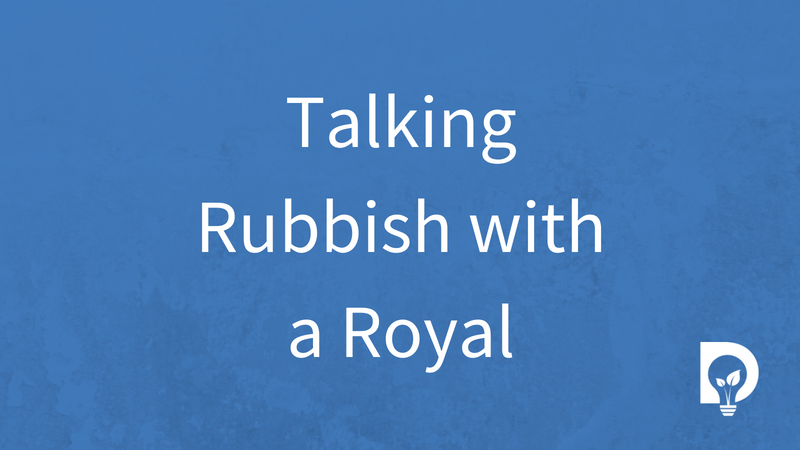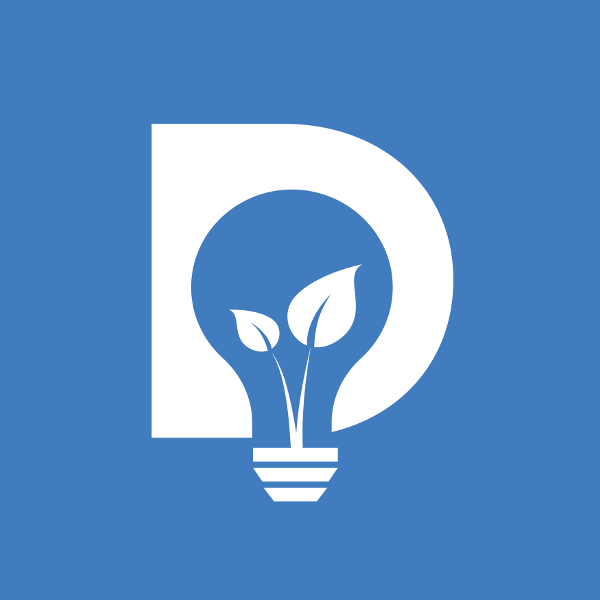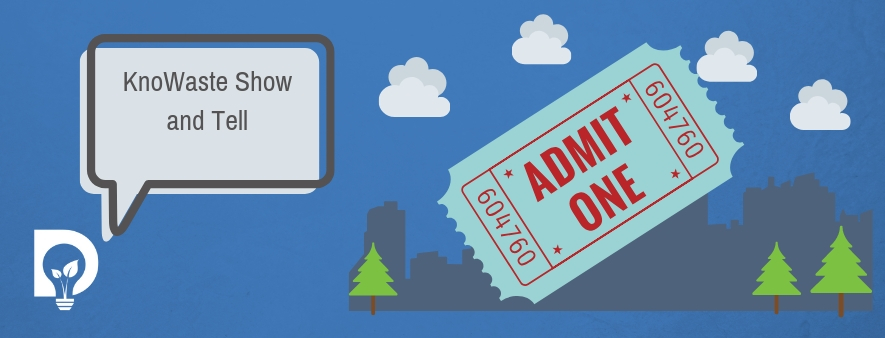
We have now finished the three month feasibility study for the GovTech Catalyst challenge. See below the Show and Tell presentation to show the work that the KnoWaste project team did. The open data standard can be found on Github or by using this link https://getdsp.uk/waste-standard.
Show and Tell
Show and Tell Transcript
Note: The Dsposal KnoWaste Show and Tell has been made to be watched and listened to and not read. We strongly encourage you to watch and listen to the video, which includes emotion and emphasis that's not on the page. Transcripts are generated using a combination of speech recognition software and human transcribers, and most definitely contain errors. Please check the corresponding video before quoting in print.
Slide 1 - Introduction

Hi I’m Sophie, And I’m Tom. We’re the cofounders of Dsposal and we’re excited to tell you about what we’ve learned on this Smart Waste Tracking feasibility study, which we’ve been calling KnoWaste.
Slide 2 - Status quo is not good enough
Where did we start? We started by wanting to solve this problem.
The status quo is not good enough – we’re destroying the planet and more of the same is not going to fix it.
Waste and resource management is key to solving these issues, but the current system is broken, we have huge data gaps, lots of illegal activity, so many wasted resources – it is a complex problem and even chaotic at times.
We need to use Systems thinking to really solve it, because it is a system and it’s a systemic failure.
We cannot solve this by simply designing a new digital bolt on or tinkering with the current system.
We need to find a way to a different place.
Slide 3 - Promised land
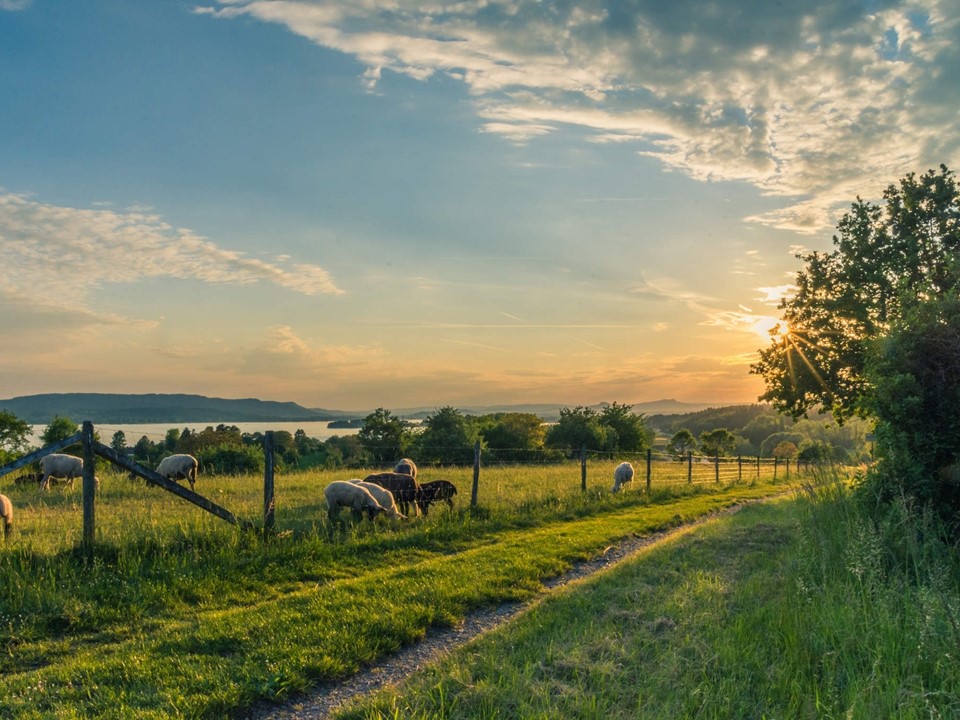
We need a systemic and holistic solution.
At Dsposal we believe that to do that we must improve the data we have on waste and resources – without good data we can’t make good decisions.
We believe in creating a system of passive compliance so it’s easy for people to do the right thing.
We need to understand what resources we have moving around our supply chains and waste pathways so we can use them more effectively and efficiently.
And we have to create the right environment so we can transition to a circular economy.
But for this to really work and for it to have the impact it needs, we must empower waste producers by giving them the tools and information for them to take responsibility and control.
Slide 4 - Original KnoWaste

Our initial idea for this Smart Waste Tracking Solution we saw as a 2 part solution, but really it was 3 parts – the web app and the central database built on the open data standard.
You might remember this slide from the inception meeting. So our research was focused on these components.
Slide 5 - Limitations

Because of the limited time available for the project we limited the scope of our study. We only looked at England, we only focused on business waste by using Facilities Management companies as our test subjects and we did deep-dive investigations into 2 waste pathways.
We work in an Agile way and so we embarked on our discovery phase.
Slide 6 - Defra's discovery work
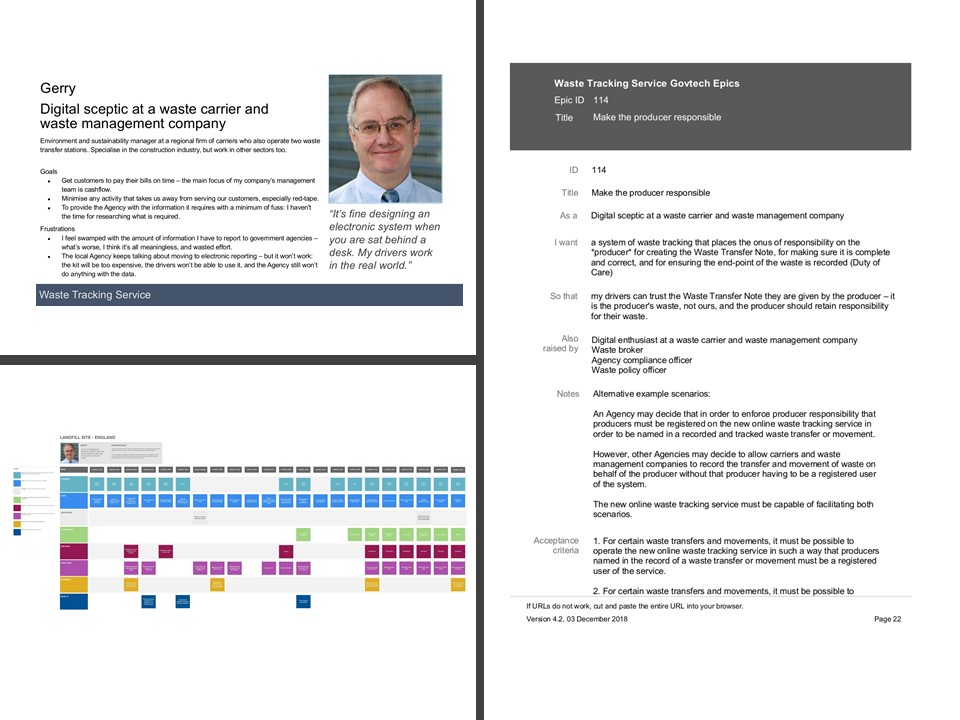
One of the first thing we did as a project team was to get to grips with excellent discovery work that Defra had done.
This body of information was really useful for our non-waste industry partners, Open Data Manchester and the University of Bradford to help familiarise them with the users, the waste pathways, and the industry and for us it was great to have our experiences of the industry validated by this rigorous research.
Slide 7 - Workshops

Because the Defra research did not include our specific test users – Facilities Management and their tenants – and because we think there’s enormous value in engaging with the stakeholders at the earliest possible stage we ran 3 Stakeholder Workshops. These uncovered new findings and helped Open Data Manchester to develop the prototype open standard.
Slide 8 - Wood waste pathway
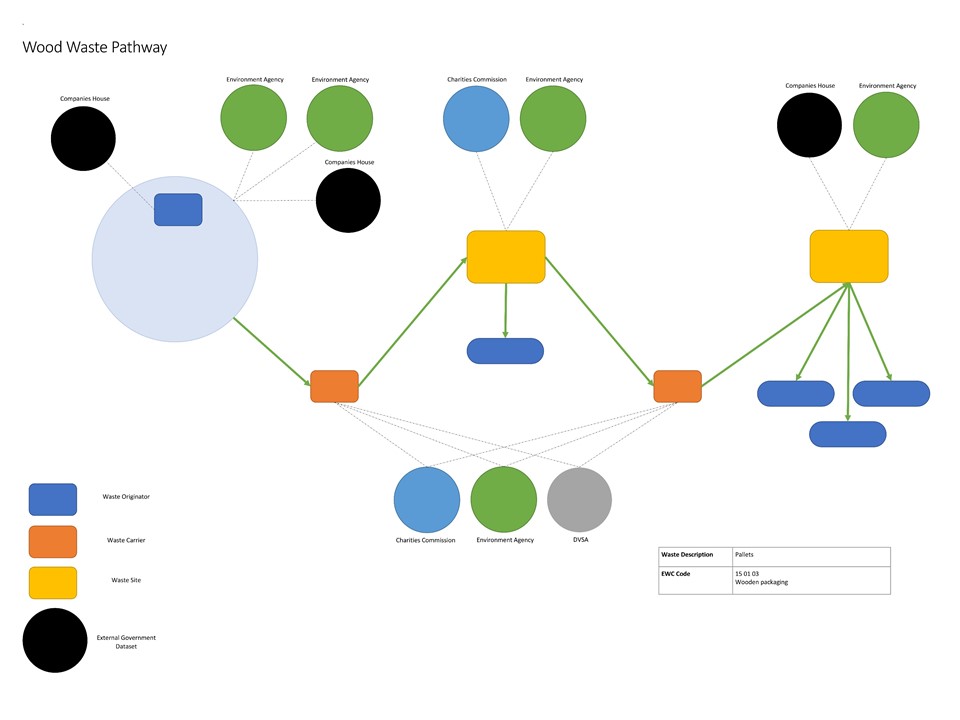
We investigated the pathways of our two waste streams, we tried to do a third but couldn’t get the stakeholders engaged due to a contract being re-tendered.
We gathered the paperwork, audited the Facilities Management sites and spoke to the actors along the waste pathway to really understand how the waste pathway worked.
Slide 9 - Food chain map
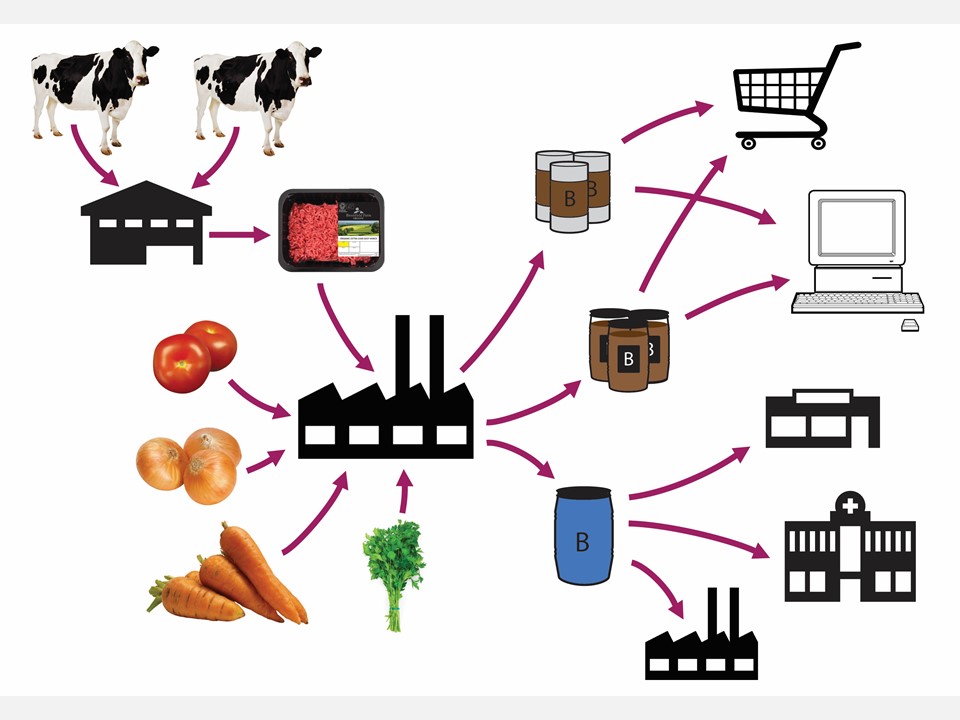
We also explored other systems to see if we could learn from them and the one we found was most relevant was food. There’s a complex supply chain but traceability is baked in. There’s a standard which enables food to be traced to batch level, but that standard does not dictate how the information is collected and stored. It is Solution agnostic if you like.
So in this simplified food supply chain example cows go into an abattoir and come out as mince which go to a Bolognese Factory along with tomatoes, carrots, onions and herbs. These all get made into Bolognese in various forms - cans, jars and bulk – and then get sent off to different outlets, so supermarkets, online shopping, cafés, hospitals and factory canteens.
It’s true that you can’t determine which carrot ended up in which jar of Bolognese, but you can determine which batch of carrots ended up in which batch of Bolognese and we think if that’s a good enough level of traceability for food, that should be good enough for waste.
Slide 10 - Waste chain map
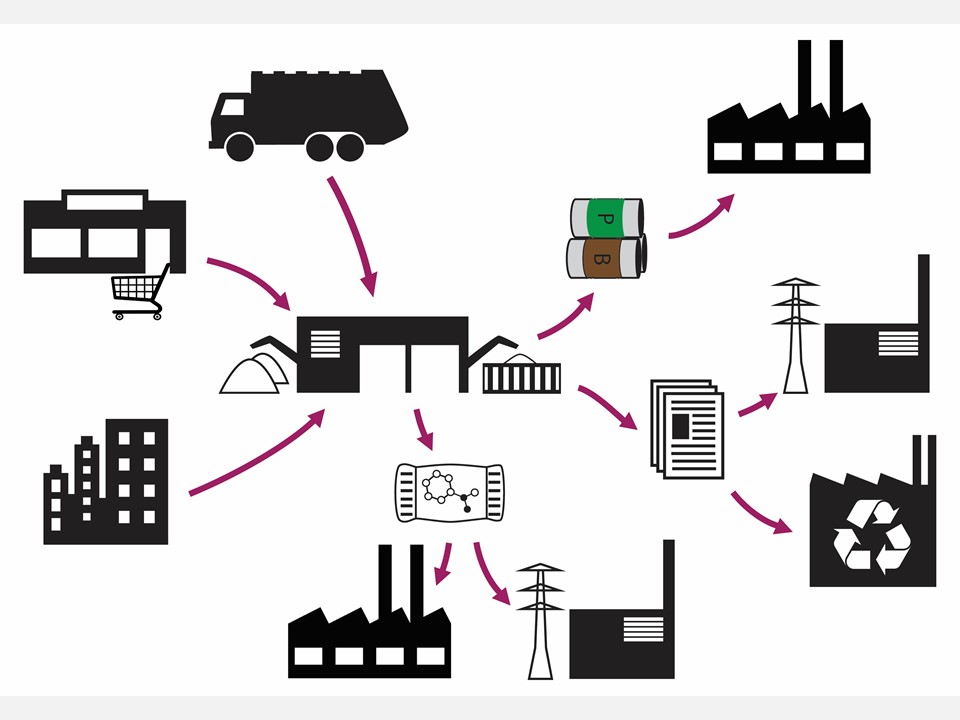
This is a simplified waste pathway. Waste from offices, shops and homes ends up at a MRF where it’s separated out and then cans go off to be recycled, paper goes to energy from waste and to a reprocessors and plastics go to a recycler or energy from waste. It looks fairly similar to food.
But there are 2 critical differences between food and waste – one is shelf life, food almost always has a shelf life so stock rotation is enforced. The other is that generally the materials moving through the food supply chain have a value so the suppliers know how much they have, what it is and what its worth.
In waste that is generally not the case.
Waste has been seen as a burden, something that generally costs to get rid of so the producer generally doesn’t really know how much they have, the specifics are often unknown or unrecorded and there’s an assumption that there’s no value in it. Partly this is because there isn’t much value in a bin of ‘stuff’ it is just waste. In the same way you’d be unlikely to get a good price for a pallet of non-descript veg. But if we can start properly identifying the actual materials in waste and if that data is tracked through the pathway well then that bin of stuff can begin to be seen as the resources it’s made up of and then we can start to see the value in it.
Slide 11 - User testing
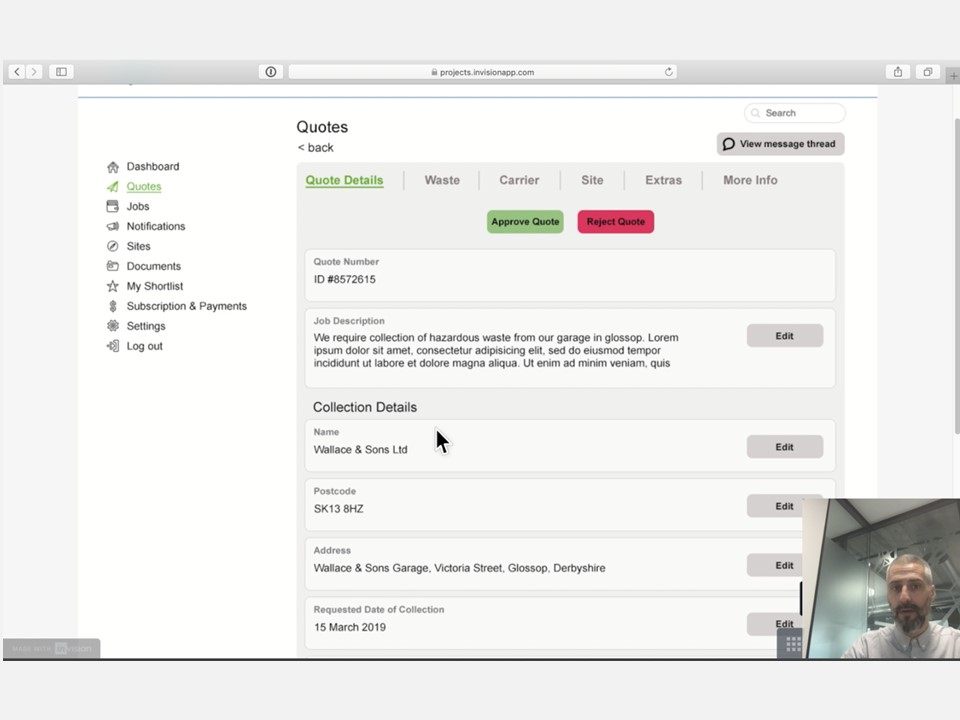
Once we understood the pathways better, were more familiar with our user needs and learned from other industries we worked with a UX and User Research specialist to design wireframes and create a semi functional prototype that we could use to carry out Usability Testing.
12 usability tests have been carried out so far. 5 on the Waste Carrier user workflow and 7 on the Waste Producer workflow as well as an initial test of the test on my Uncle Brian, who in terms of digital scepticism gives anyone in the industry a run for their money.
Slide 12 - Technical feasibility
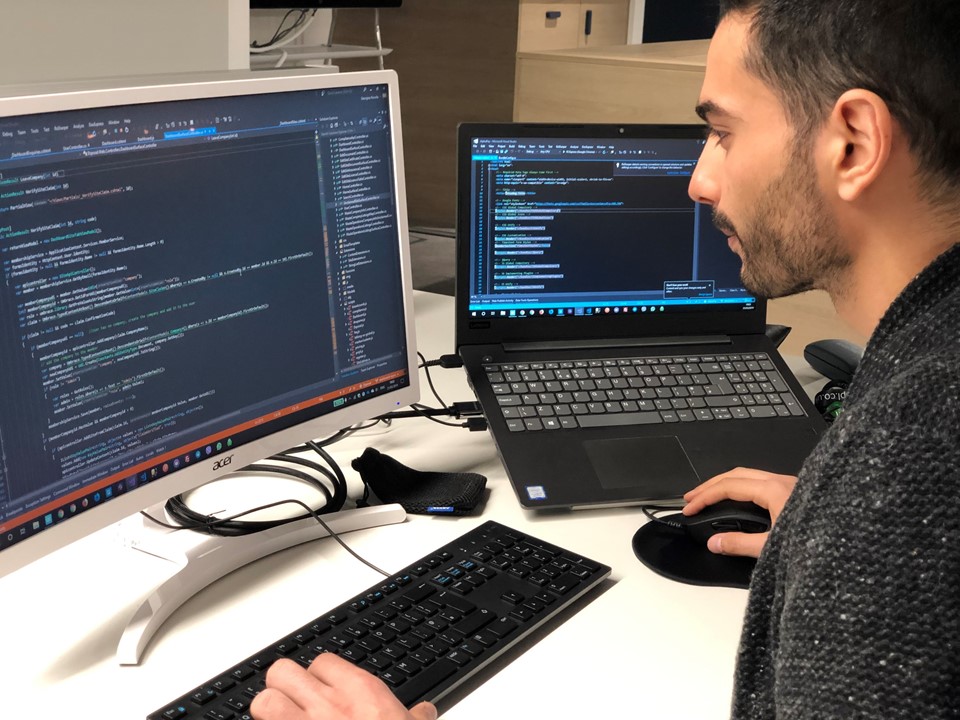
And of course we looked at the technical feasibility of our solution – researching the current state of the art and how best to design and build the interlocking parts of the solution.
Slide 13 - Learning

So those are an overview of how we went about learning and a few bits of what we learnt.
The most important things we learnt though were:
That the current system is overly complex. Yes we knew it was complex, but actually understanding how this negatively impacts on users regularly was important. Like that our facilities management companies were paying for sanitary waste to be disposed of as hazardous waste, when it’s not actually hazardous, but they were led to believe it was by their waste contractor.
We learnt that people really want change in the industry, but they are very wary of new systems and technologies, not because they’re happy with the current system, but because they are scared to change
We also discovered that EWC codes are insufficient if we want to track waste and understand what it is. They can be too broad and focus more on where the waste arises than the qualities of the material itself. If we want to track waste and understand the resources we have flowing through the system we need to be able to categorise the waste more accurately and this accuracy will help to increase the value of the waste.
And the other major learning was that we were wrong. When we started we thought that digitising the paperwork would be a major component of the solution, but that’s not the case. In a truly smart waste tracking system it’s actually a fairly minor and relatively simple part which in fact will ultimately become redundant….
If we want to realise the potential that can be unlocked by really solving this problem we have to embark on a transformative solution that works for everyone, because we are all waste producers and so our system has to accommodate all of us with all our varying needs and idiosyncrasies.
And this is the problem.
Slide 14 - Ecosystem

And that is why we have come to the understanding that we must create an ecosystem of solutions. We talk about waste pathways, but pathways are too linear. Waste is an ecosystem and if we want to understand it properly and find ways to move to a circular economy we need to treat it like an ecosystem where one things waste is another things food and that for it to flourish and be sustainable we need it to be diverse and accommodate all the different actors in it.
User needs are complex, we can’t solve it with a single solution – we need to create an ecosystem of solutions to fit with the ecosystem of the industry. Again we can look to other industries to see how this has been done well before.
Tax, like waste, is another thing that every business has to deal with and HMRC approach to making tax digital has opened up the market for a wide range of software solutions.
Slide 15 - The idea
![]()
So our solution has evolved. We’ve realised it is unfeasible for us or anyone else to be able to come up with a single software solution that works for everyone in every situation. So we no longer see the answer as the 3 parts we initially envisaged. Those parts are still there – the web app and the central database built on the Open Data Standard.
But if we really want to be able to track all waste and create a solution that meets all the epics then what we need to do is build tools to open this market up. To create an environment that stimulates innovation. Those tools are the Open Data Standard and the APIs – these will allow any developers to create solutions for the industry so rather than having one solution which undoubtedly won’t work for everyone brilliantly and which certainly will fail to allow for every edge case or niche user need we can have as many solutions as needed. But we also have to pave the way to make it easy to bring everyone along so no one is left behind by this digital transformation and create a ways to manage this transition so we also need to create a data landing portal so that people can upload flat files from their legacy systems be that a bespoke software or just plain old Excel.
Let’s look at each of these elements in more detail, starting with the open data standard.
Slide 16 - Open data standard
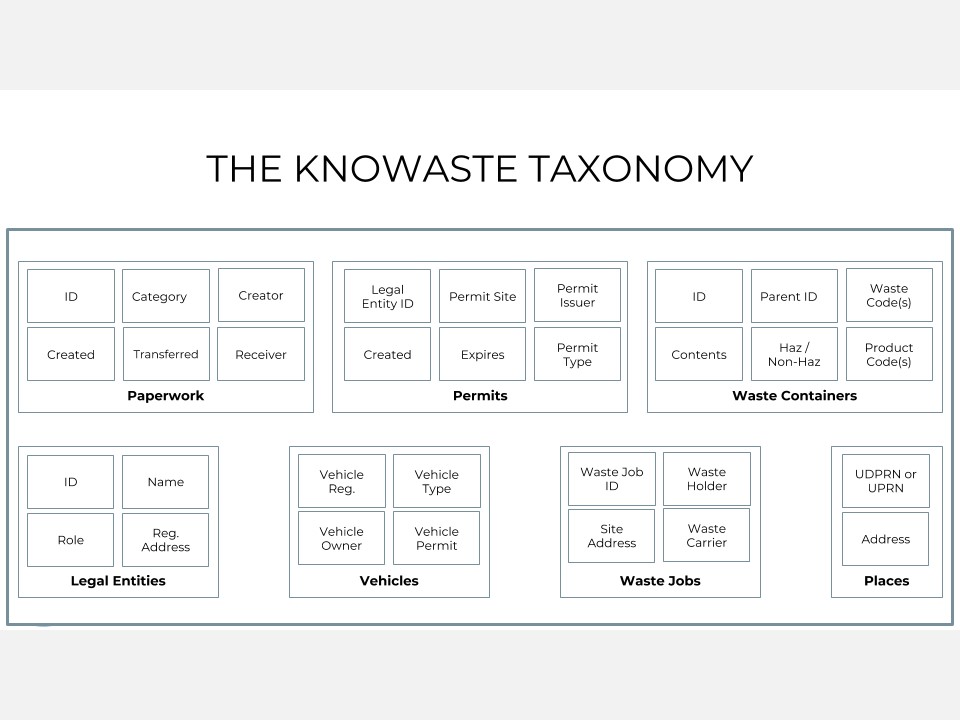
The foundations of this holistic solution is the Open Data Standard for waste. It’s important to note that an Open standard is not a technology, but its adoption allows for technology to thrive.
We have spoken to many of you already about why standards are so important so I won’t go through that again now.
I will just stress again though that one of the critical components of the standard is creating unique identifiers which will be linked to the waste transactions and allow the waste to be tracked along its pathway.
Slide 17 - Github
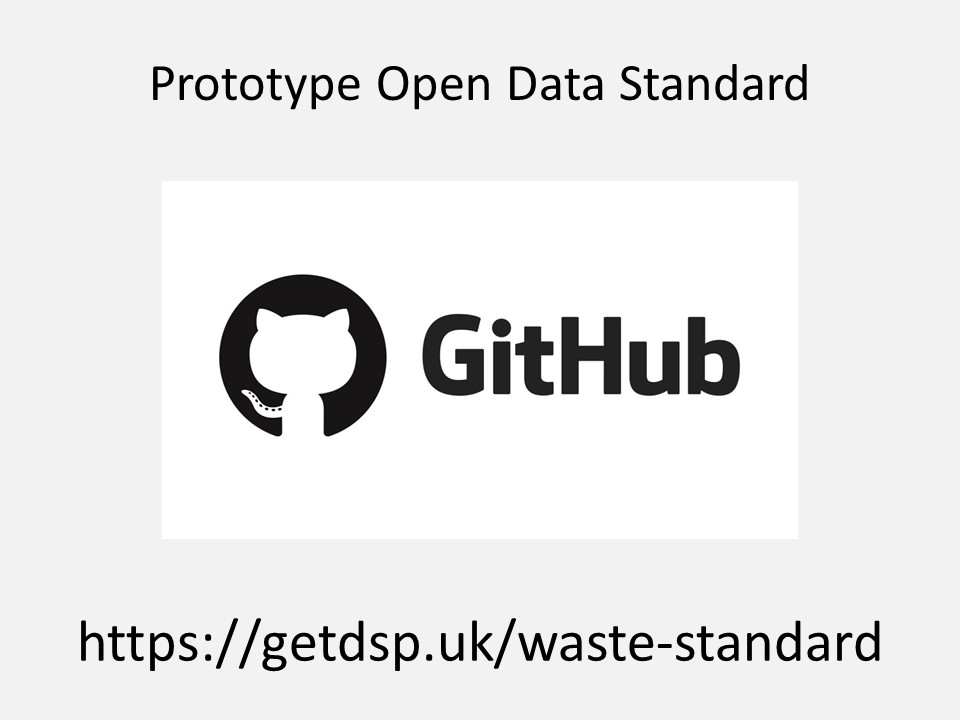
Another important point is that an open standard has to represent the world of the stakeholders, their actual experiences so it must be built with them, which is why we have engaged with them from the start to create the prototype which is already live and published on GitHub - https://getdsp.uk/waste-standard.
I’d like to take a moment here as well to acknowledge that of course many, many people, I’d say the majority of our stakeholders, have no idea what GitHub is, how it works or how they can get involved. We understand that. Throughout this project we have felt that tension. That communication hurdle. Because as we’ve said waste is something which we all interact with, so our potential user group is enormous with vastly differing understanding of the different component parts.
If a solution is going to work it needs to find ways to speak with all the stakeholders in their own language and engage them in in their environment so we can understand their world. It must be built with them, not imposed upon them.
Slide 18 - Furman Report
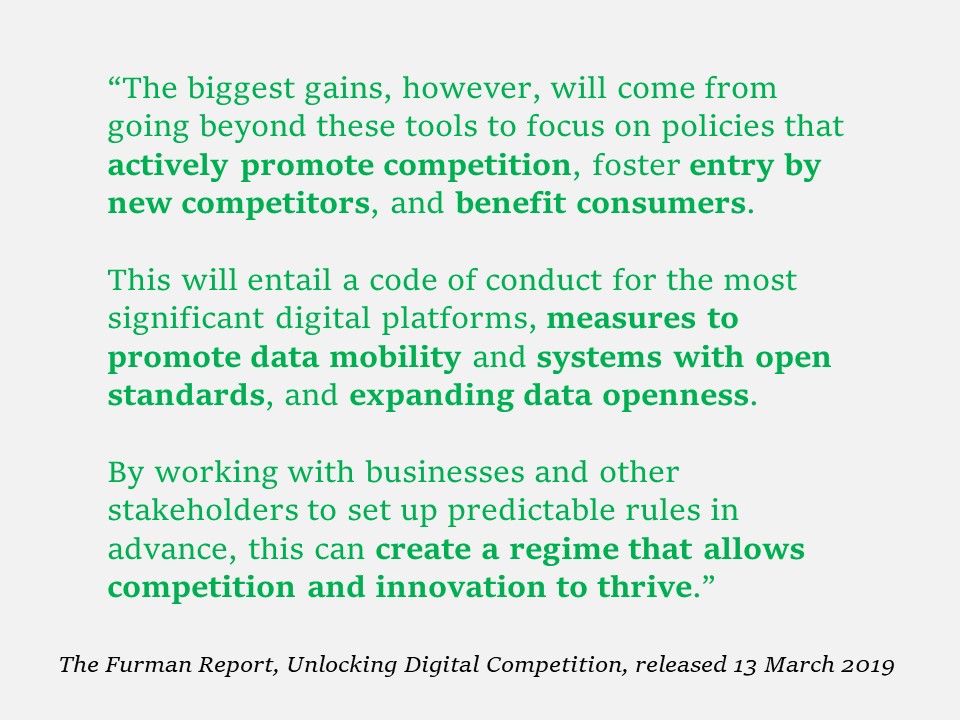
“Open Standards are one of the most powerful tools we have to open up government. They make it possible for the smallest supplier to compete with the largest. They make data open for any citizen to audit. They unlock the transformative power of open source software.” That’s taken from the foreword to the https://www.gov.uk/government/publications/open-standards-principles/open-standards-principles
The UK Government Commissioned the Furman Report which was released just a couple of weeks ago which also concluded how important open standards, data mobility and data openness are to allow competition and innovation to thrive. That is what we want our solution to do.
Slide 19 - The idea
![]()
Let’s now look at the Data Processing and API Layer
API stands for Application Programming Interface. They’ve become a totally ubiquitous bit of tech, even if you’ve never heard of it before you probably use loads of apps or software that are powered by APIs. They are a way for different bits of software to get, put, post, update and delete data between themselves.
Slide 20 - APIs
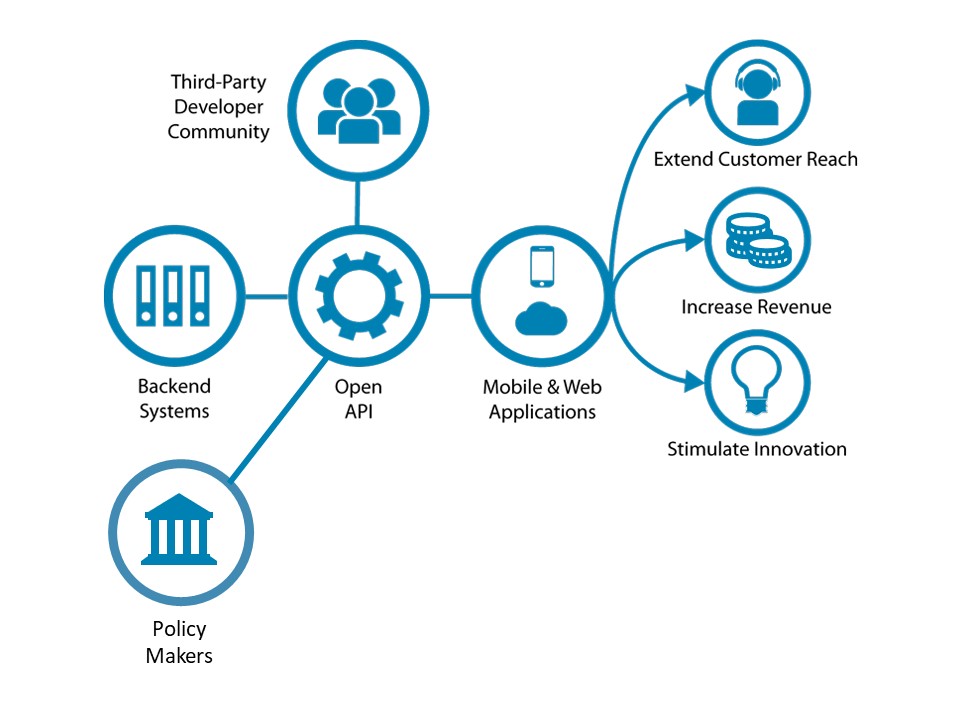
At the start of this project we saw building APIs primarily as a way to meet the Epics around interoperability. But actually building APIs does much more than that.
APIs allow other developers to create new software, new solutions to cater for the vast array of user needs. Banks were recently required by Open Banking to conform to the open banking standard and to build APIs which have enabled multiple new services to emerge which allow consumers to take control of their data.
APIs also provide an additional revenue stream - we will charge per call made to the APIs which is a standard business model for them. This revenue can be used to fund the database, the APIs and the Open Data Standard.
Not only will these APIs provide a link between the central database and third party systems, they will also provide a link between policy and users. When policies and laws change, and change they have to in the coming years and months, the APIs can map these changes. Not only will users be able to track waste in real time but we can notify everybody about changes to the policy in real time – not just notify all those within the waste industry but across all industries'
The data processing layer allows for validations on the data to ensure the quality of the data. Most of these data processes will be fairly standard operations to clean all the data that is pushed to it. Trimming, parsing, validations and sense checking. More complex function will have to be built and maintained that are waste industry specific.
Slide 21 - The idea
![]()
For legacy users and other reports, a data landing portal is key.
Slide 22 - Data Landing Portal

The Data Landing Portal allows legacy software users to upload flat files, like CSVs. I have experience of working with these at the NHS and it transformed the way the teams worked with data. We’ve been talking to NHS Digital about the project and we can use it as a template as it’s open source and freely available.
Building a Data Landing Portal has additional benefits as it creates a central platform that can be used for any or all other environment data such as the bio resources data sets the water companies have to produce.
It’s important to note that the data landing portal will be validating the structure of the files being imported – for example confirms that the number for fields being imported matches the number of fields in the system. It does not clean the data. However within the NHS Digital DLP users are provided a validation report once the data has been reconciled and cleaned.
Slide 23 - The Idea
![]()
Now let us talk about the Central Database.
Slide 24 - Central database
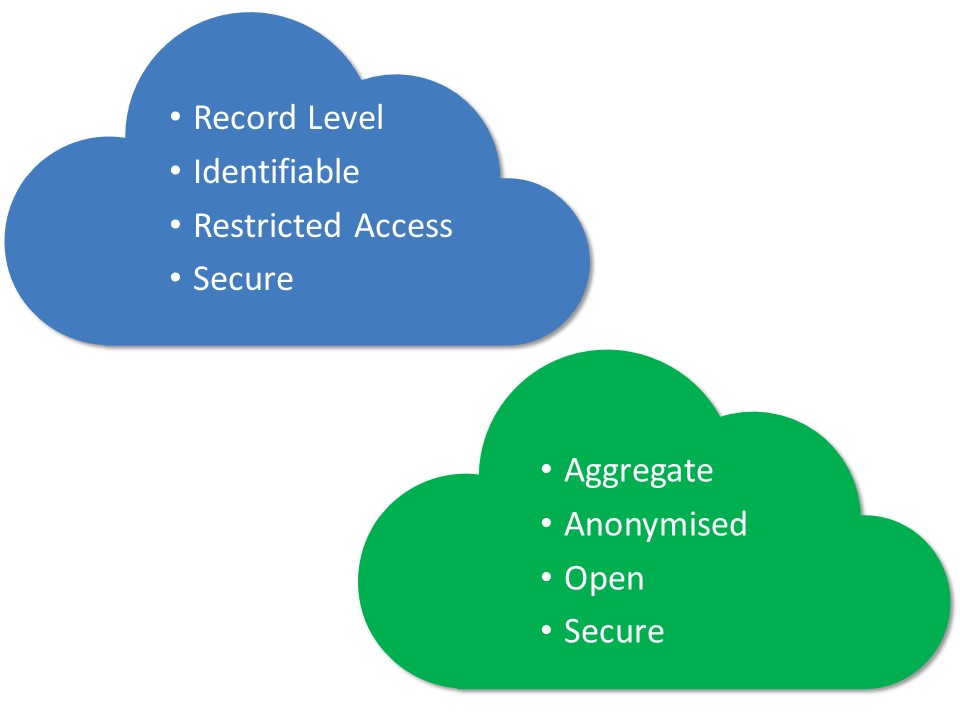
The central database is actually 2 databases – one is the record level data the other the aggregated anonymised open data.
The central databases are the core of the smart waste tracking solution and will include reporting functionality for the regulators along with notifications or flags of unusual activity. These reports will be handled through the API and data processing layer. So we can also build in reporting for the waste companies and waste producers adding value to them by providing useful information to them. One of the features that Facilities Management professionals we surveyed said would provide them with the most value was better reporting.
And by releasing the aggregated anonymised open data we can help to drive innovations and better decision making as anyone will be able to interrogate and exploit this data.
Slide 25 - The Idea
![]()
Next we are going to focus on the Web App.
Slide 26 - Dsposal KnoWaste web app
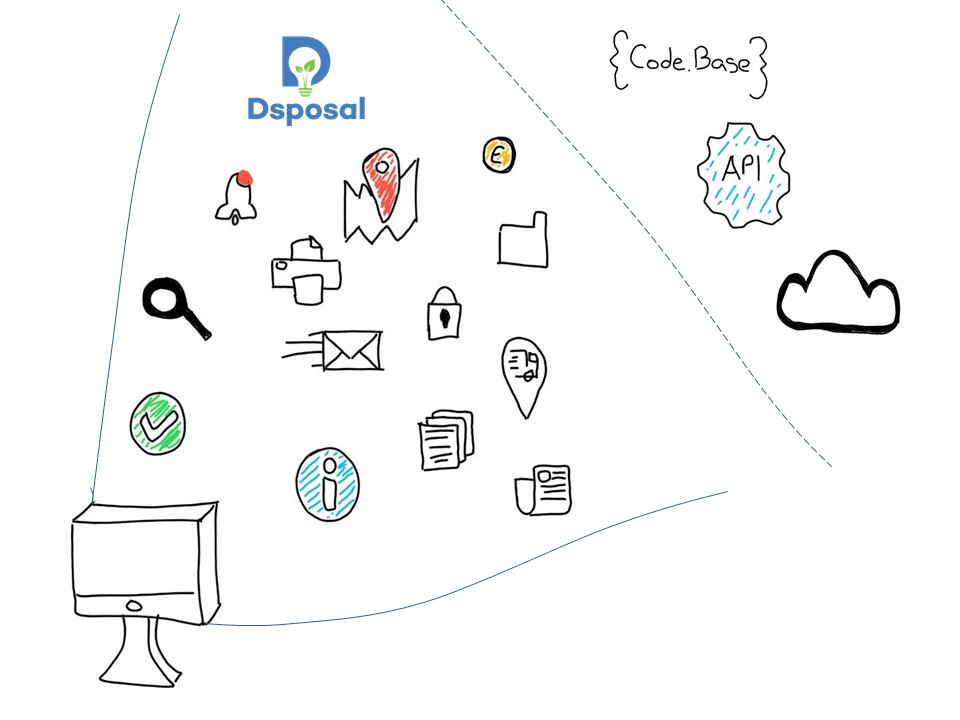
The final part of our solution is our own Dsposal KnoWaste Web App that will digitalise the entire waste pathway – electronic documentation, electronic payments, in-app guidance to help with waste classification, only being able to choose a licensed waste carrier to take your waste away, being able to see where your waste had gone and the carrier only being paid when they had handed it over to a licensed site. Putting the power back in the hands of the waste producers, by giving them the tools to take proper responsibility for their waste through a system of passive compliance – i.e. make it easy to do the right thing and make it harder to do the wrong thing.
We wanted this app to be free at point of use and be built on a transaction fee model but our research has highlighted this solution might not work for the large Facilities Management companies we’ve been talking to so we’re looking at other models too.
Slide 27 - Wireframe
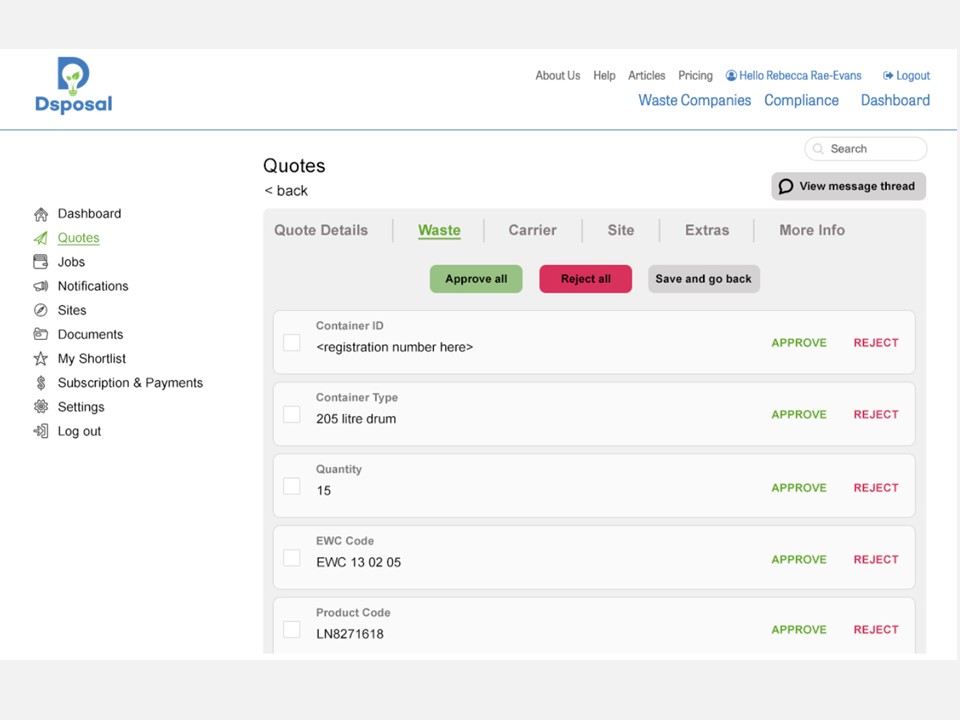
As we mentioned earlier, we’d initially thought that creating digital versions of the legal paperwork would be critical to the success of the solution, but actually digitalising the whole transaction offers better benefits to our users and by starting at the company selection and job quoting stage we are able to minimise the need for double entry of information, the information that is entered to request the quote and book the job gets pulled through to all the other necessary paperwork.
When we plotted out the user journey the collaborative quote building functionality was one of the most complicated aspects and the one we didn’t know if our users would ‘get’ so that is why we have chosen to test this functionality first.
It’s also the logical next step in terms of building on what we’ve already got on Dsposal – you can already find licensed sites, check their static Duty of Care documents, use the waste thesaurus to determine the right EWC code and request a quote. Being able to build that quote in the web app and store that information as a waste producer is what we’re testing currently and will build next.
It’s important to mention that the web app will talk via the APIs to the central database, but the information around the quote that is not relevant to smart waste tracking or required by regulation will not be passed to the central database – like the monetary elements of the waste job or notes about the job.
Slide 28 - Business Model Canvas
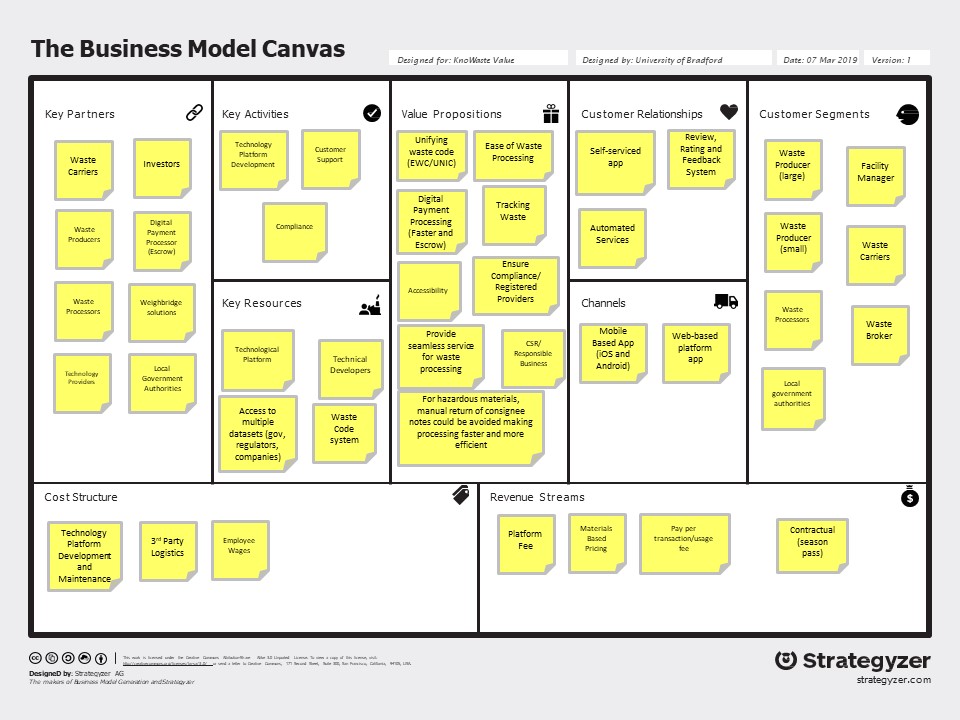
As I said the business model we were planning on deploying, the transaction fee model, may get amended or added too. There’s also a number of other potential business models we’ve explored, particularly with regards to incorporating more Circular Economy components. This is a Business Model Canvas, it’s a tool used by the Lean Startup approach rather than writing a business plan.
When we started the project the Web App was the main commercial part of our solution but in creating a suite of APIs we’re opening up a different revenue stream. More importantly though by developing these APIs and creating an Open Data Standard we open up the market so it’s not just creating new revenue streams for Dsposal.
Slide 29 - Parks
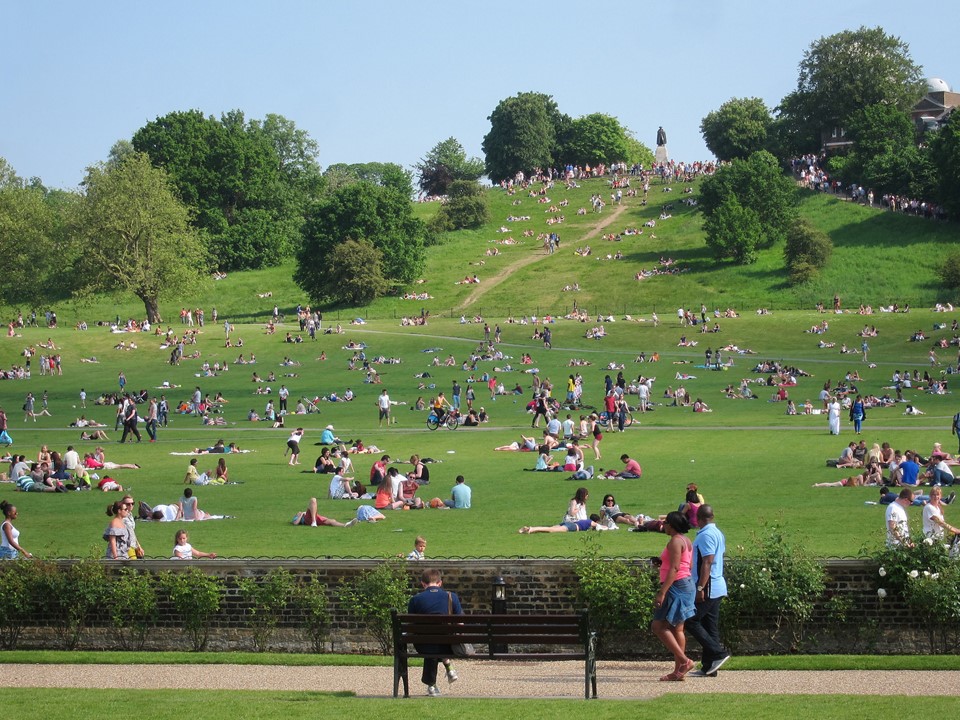
And that has been for us the most critical piece of learning.
Our understanding of the most important user needs is that there is not a single set of user needs so we can’t design a single app or bit of software that will serve them all. What we need to do is create the right environment that means that people can get what they need from the system – A park doesn’t dictate how you use it, but it’s an asset for the community and people use it in a wide variety of ways.
By building tools for the waste ecosystem we can create a space in which many people can use it in a loads of different ways, including ways we can’t even imagine now. I can’t imagine the Victorians would have foreseen the advent of something like Parkrun.
Slide 30 - Plugs
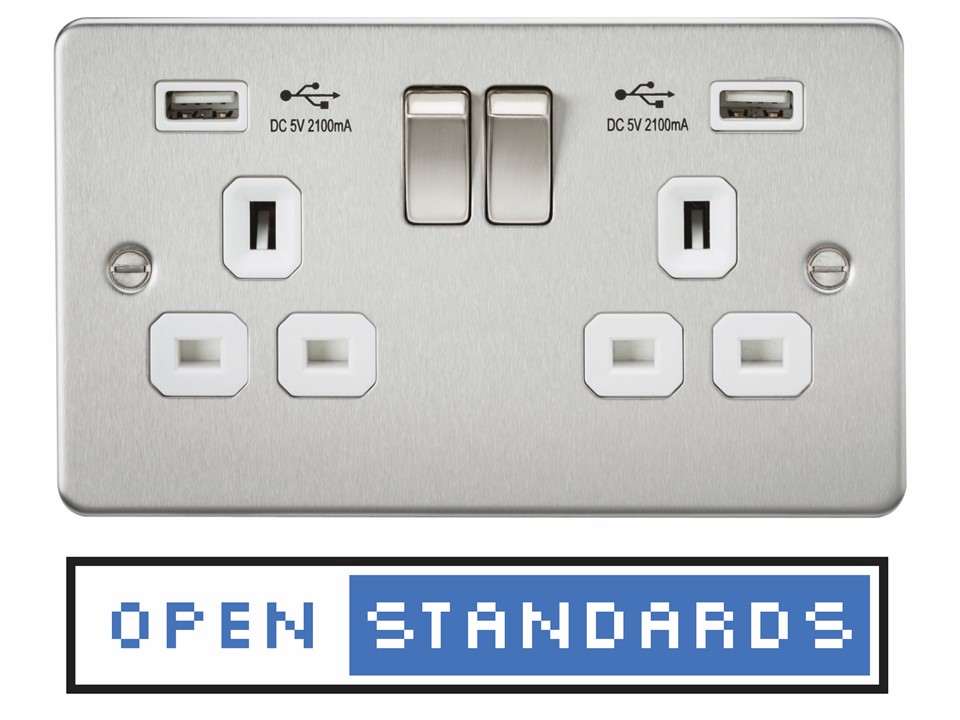
But digital transformation is disruptive and people are wary of change so we need to build trust. Open standards help to do that as they provide an open set of rules about how the game works so that people know how to interact and be successful.
Here are two examples of open standards which have transformed and powered the way we all work rest and play – the USB and the 3 prong plug – utterly ubiquitous tech that we all interact with all the time.
Slide 31 - Maximise, improve and minimise
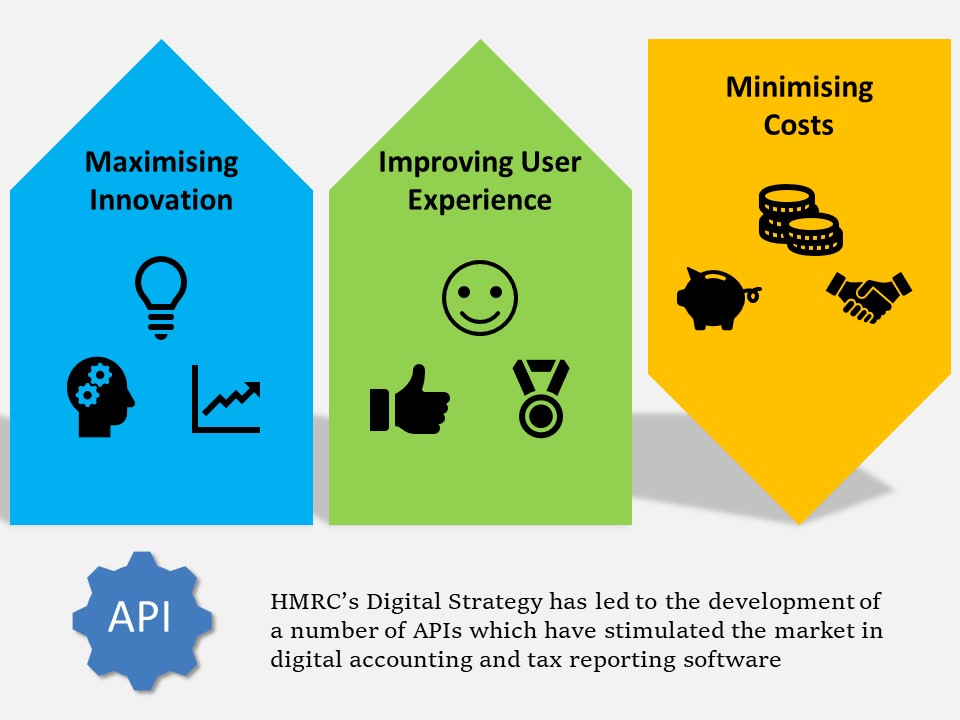
And the benefits of APIs we’ve already touched on, but it’s worth mentioning again. They provide tools to developers which means that the market is opened up, maximising the opportunity for innovation, improving user experience and minimising costs.
The incredible variety of accounting and tax reporting software that is now on the market is a testament to this approach by HMRC to develop a suite of APIs and we should look to do the same for the waste and resources industry.
Slide 32 - Issues
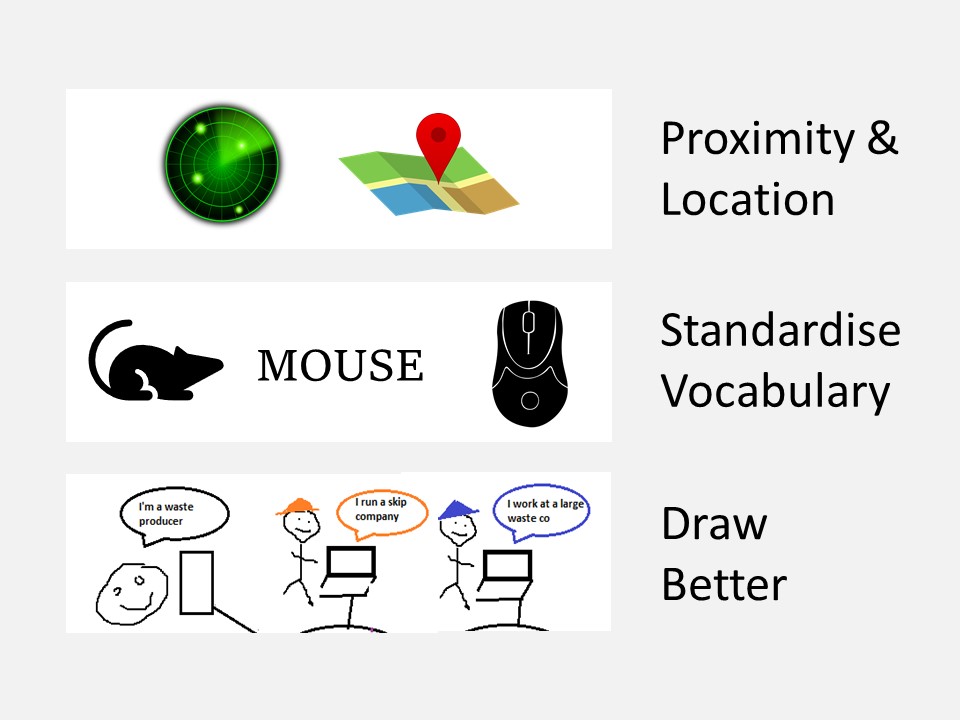
That was our biggest learning, but what would we do differently next time?
One thing that was tricky was not all being I the same place. While modern technology makes remote team work possible, in short intense projects being near each other is important so if we do another 3 month project of this intensity we’ll favour working with people in the same location.
One of the other things that was hard was all speaking the same language. We had 3 different organisations working together with their different areas of expertise and the vocabulary that comes with that, which meant sometimes we were using the same words to say different things – so we think finding a way to standardise the project vocabulary earlier on would be helpful in future.
I’d like to learn to draw better!!
Slide 33 - Revelation

Whilst reflecting on the project we had said that since we validated a lot of our assumptions via our user research that actually we could have started to design and test our prototype earlier. We know some of the central project team had hoped we’d have done more of that too. But in talking over our biggest learnings and the evolution of our thinking over the past few months actually I think it’s good that we didn’t start off down the path of focusing on the design and build of the web app, because I think then we might have got too wedded to the idea that we had to develop THE solution – that our app had to work for everyone in all situations, when the far better way forward is to acknowledge that is not a feasible solution and that actually the way we can sustainably and holistically solve this problem is by developing the tools to open the market up and connect all the different solutions out there.
Slide 34 - What's next
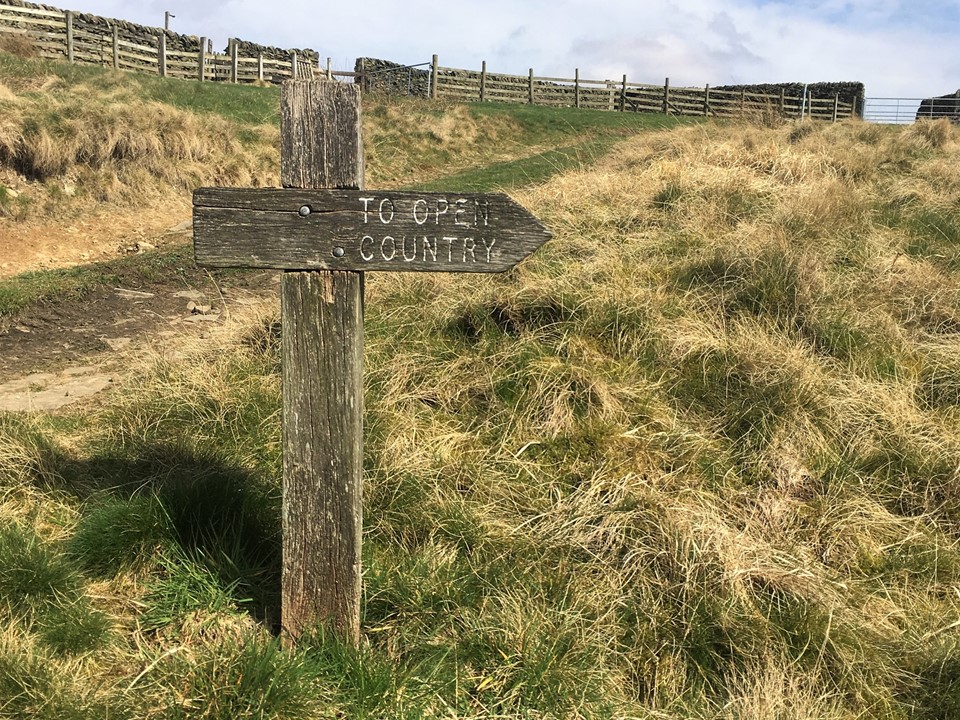
What’s next and what are the biggest risks?
We hope what’s next is Phase 2. The biggest risk to that is that we’ve not been able to speak to Defra and GDS in the right language, that we’ve not been able to convince them that by developing these tools we can unleash the power of digital transformation to completely revolutionise the waste and resources industry and how we all interact with it.
That we’ve not been able to convince you all that a truly smart waste tracking system for the whole country is totally feasible, not from a one size fits all piece of software but instead by cultivating the conditions that allow a plethora of solutions to thrive and meet the complex and varied needs of all these different stakeholders.
Slide 35 - Logos
But the way we’ve been talking about the project and our approach seems to be gathering momentum with stakeholders. Since the PR came out and we’ve been able to talk openly about the project we’ve been approached by a number of trade associations, organisations and companies, both waste companies and Facilities Management companies who are interested to learn more and keen to work with us on the next steps.
Slide 36 - Community
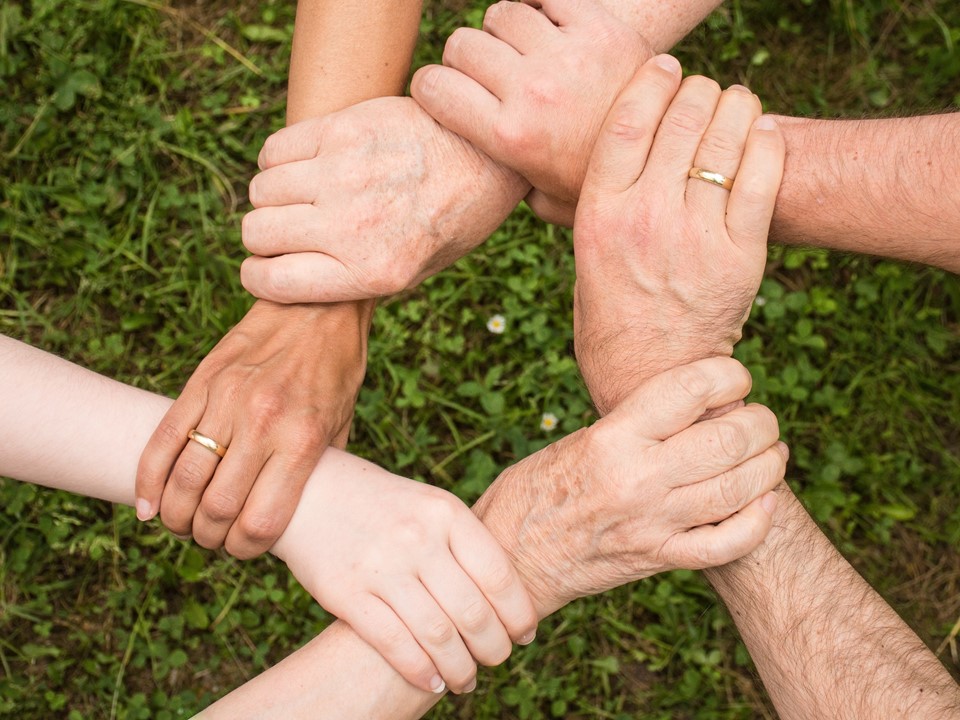
Which is great, because as we’ve said, we need to build a community to develop the open data standards so it really reflects and supports the needs of all those in the waste ecosystem. One risk around this is that we don’t engage enough with the people on the ground, that it ends up being created by the managers or policy makers. But that is why we need to ensure we don’t just create it with input from the big guys and the institutions – they’re super important and we want them involved of course, but we need to go and talk to everyone along the pathway from the one-man skip companies, to the office managers, to the café owners, to the lab technicians and everyone in between.
And of course the standard needs to be for the whole of the UK and include all the different types of waste so it will be expanded out from just England to include the other nations and incorporate household waste.
Slide 37 - Four aspects
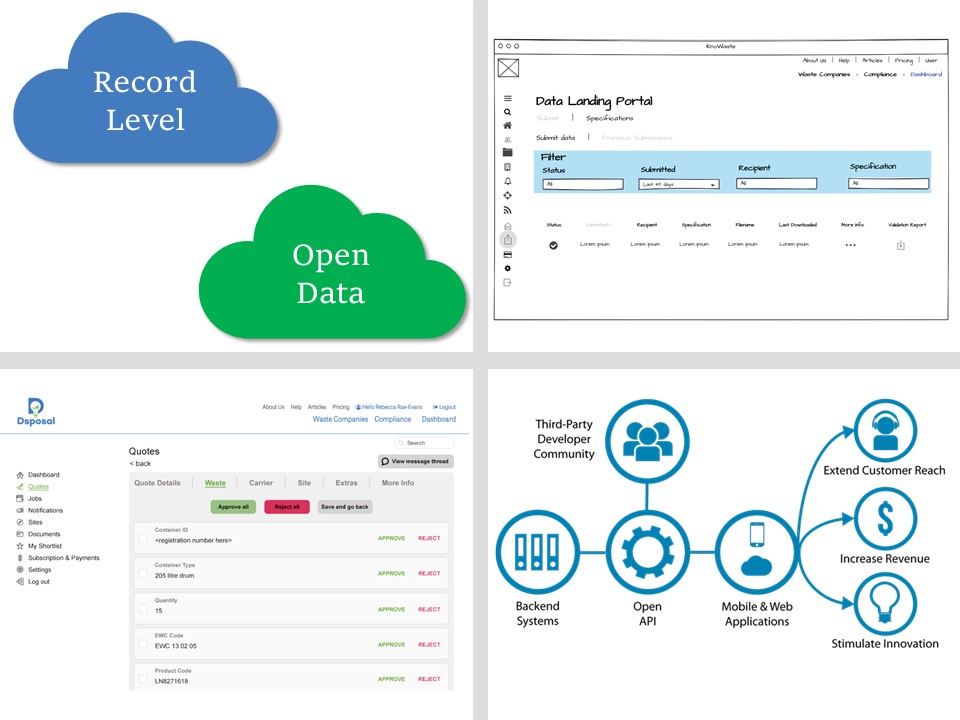
Aside from developing the standard we’ll be building the central database, the data landing portal and the data processing and API layer – these are all mature technologies in other sectors so the risks around these are minimal.
The web app development for the facilities management sector will continue to be developed working closely with the Facilities Management companies we’ve engaged with and we will explore creating alternative versions of the app to build in the Circular Economy components or for other sectors of the market.
Slide 38 - Blue sky thinking
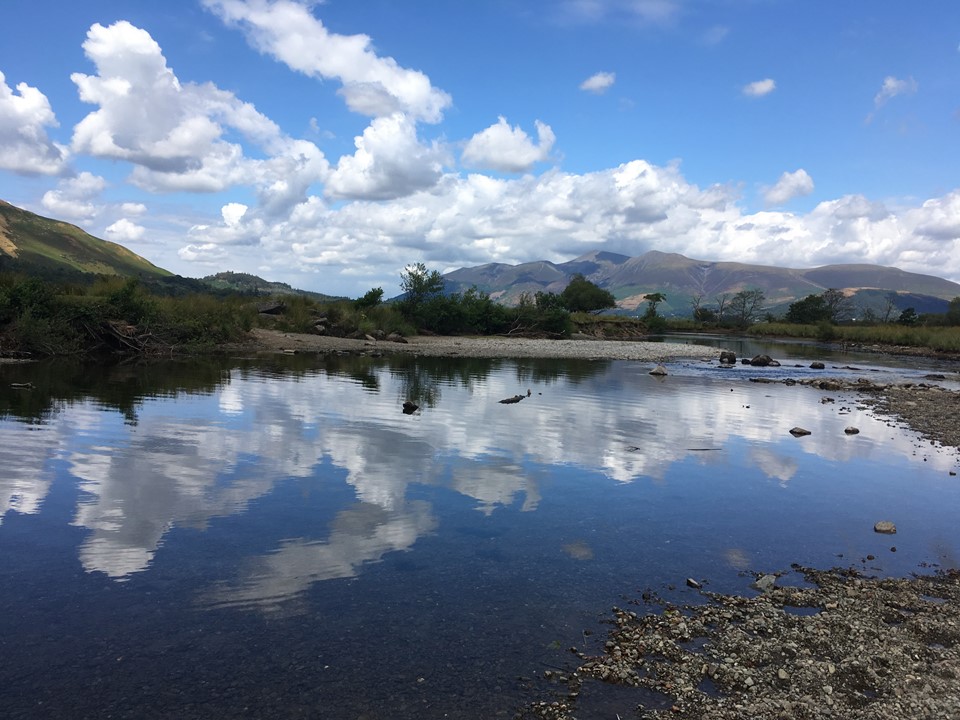
We need blue sky thinking. We can’t just tweak the old system.
But we can solve this problem and we can do it in a way that opens up the market to other innovations, other companies and other organisations.
We can use the power of open standards, open data and APIs to put power back in the hands of waste producers.
This will be a disruptive, transformative process, but one which everyone can play a part. It has to be transformative because the status quo is not good enough and we must find better ways.
Slide 39 - Get involved

If you like our approach, or have questions or suggestions we want to hear from you.
Get in touch.
Thank you.
